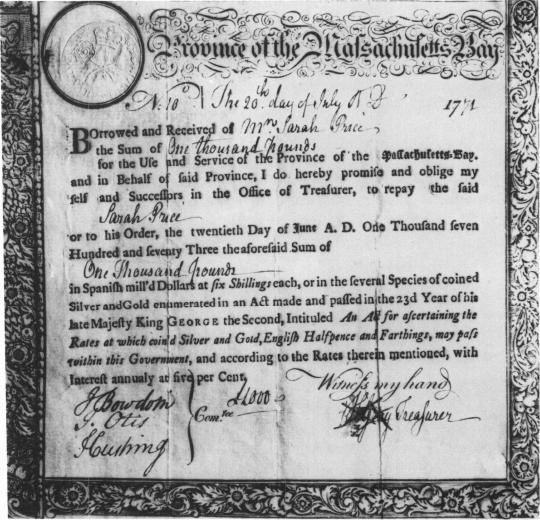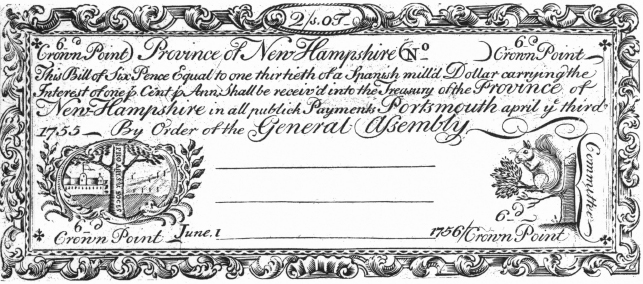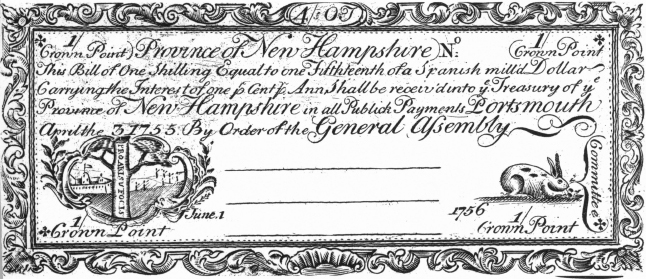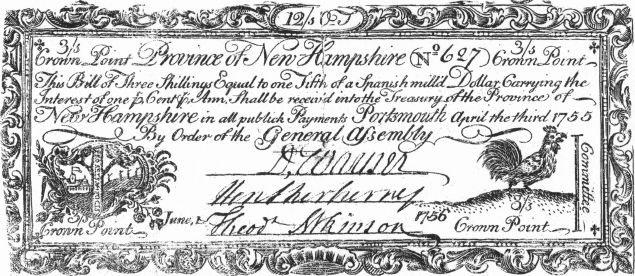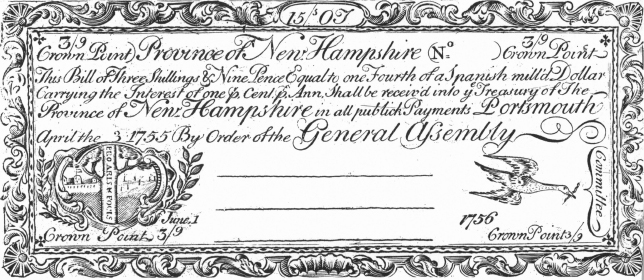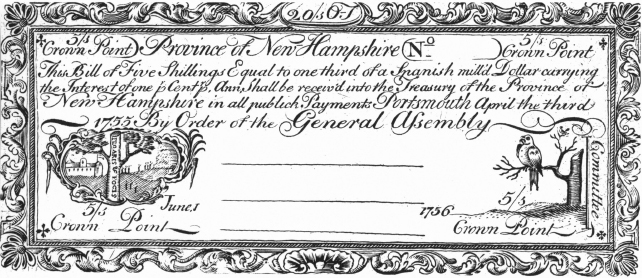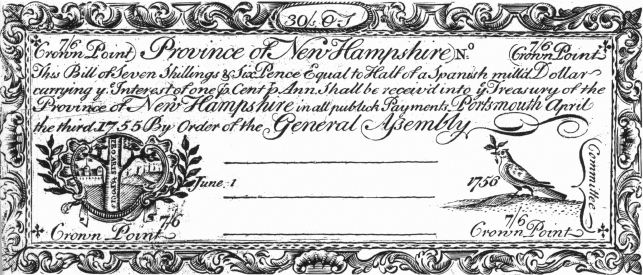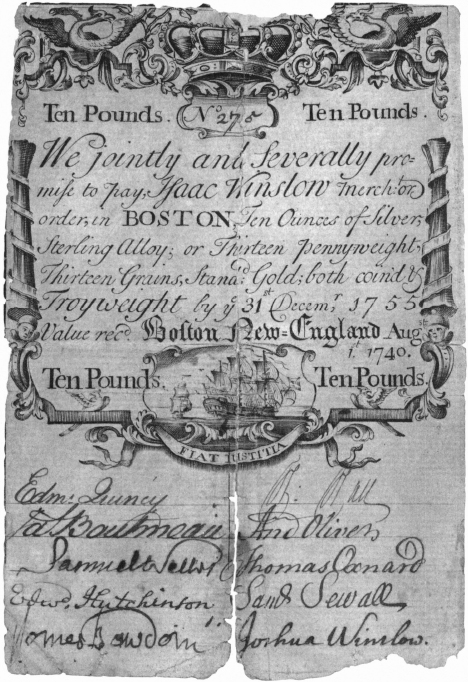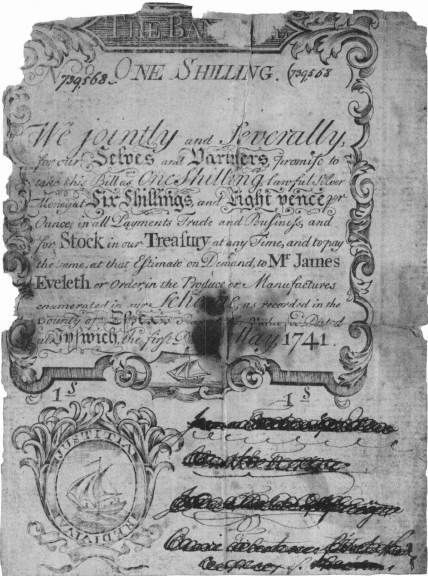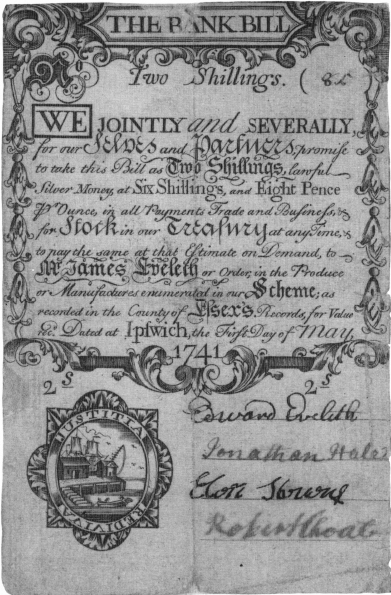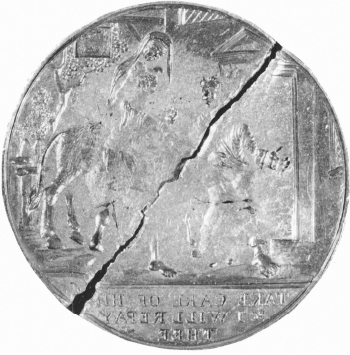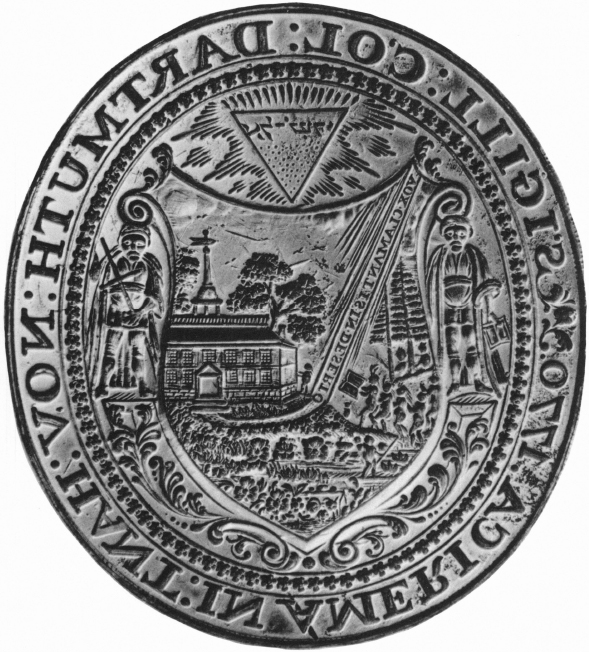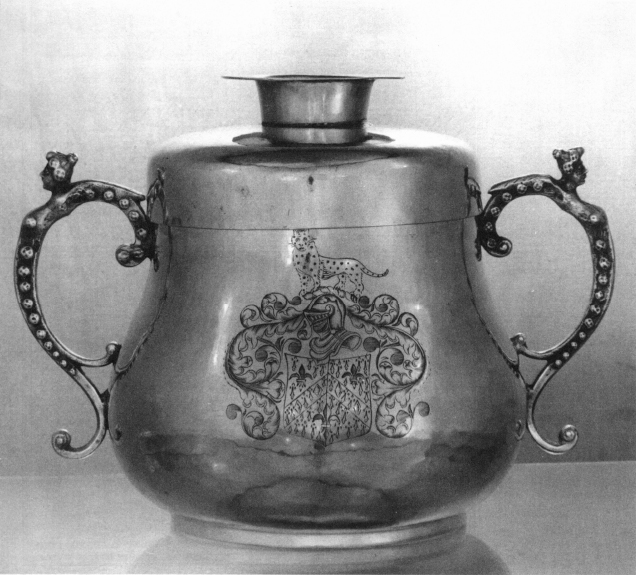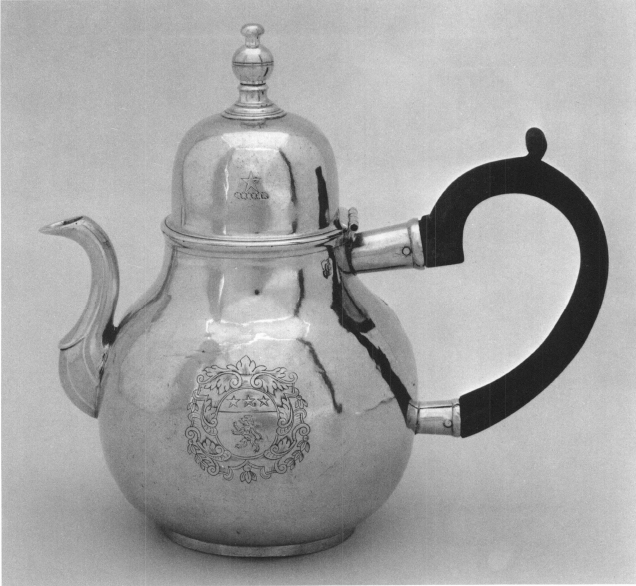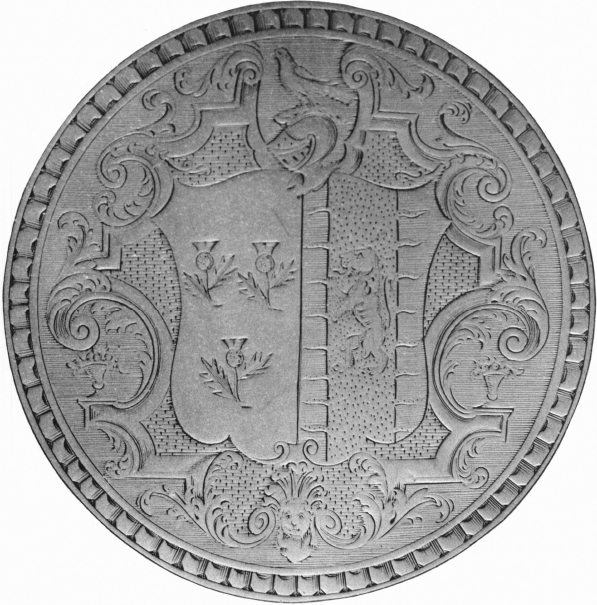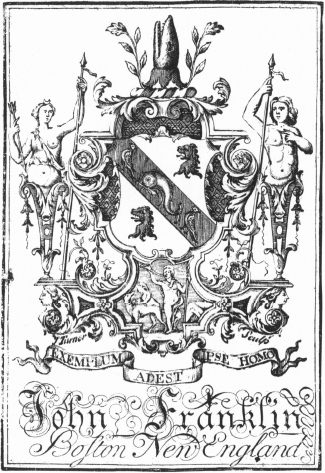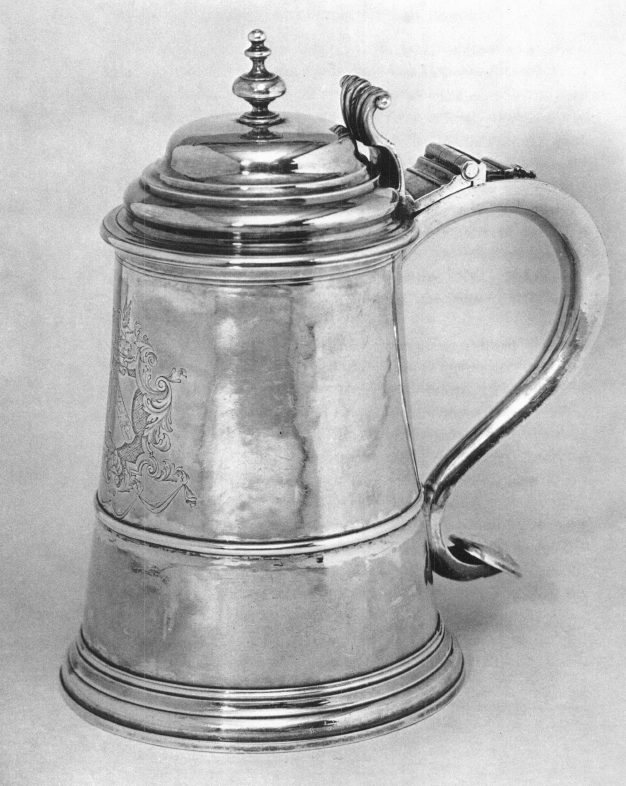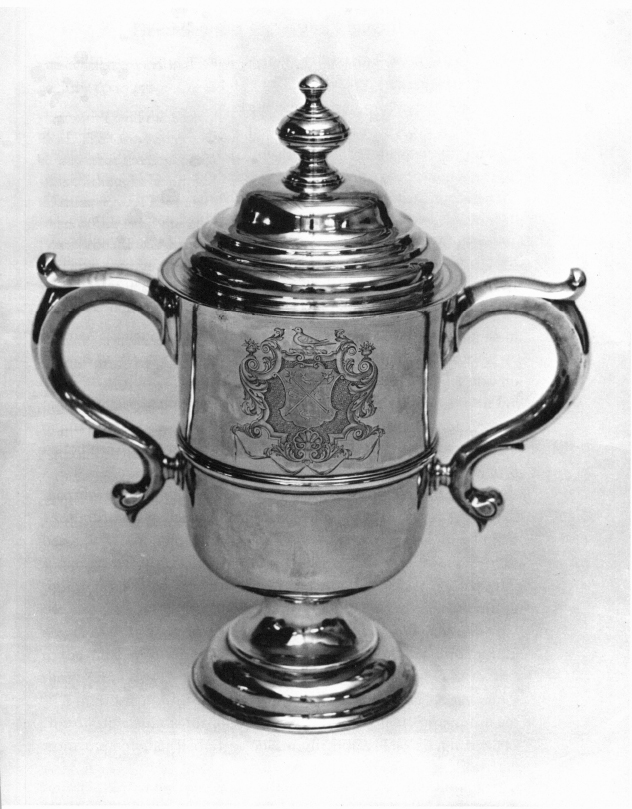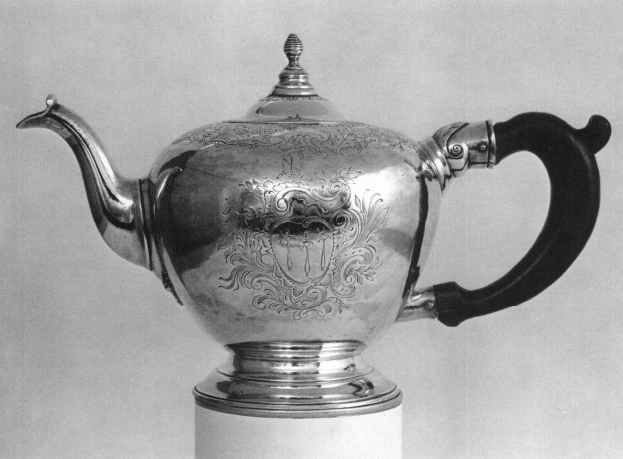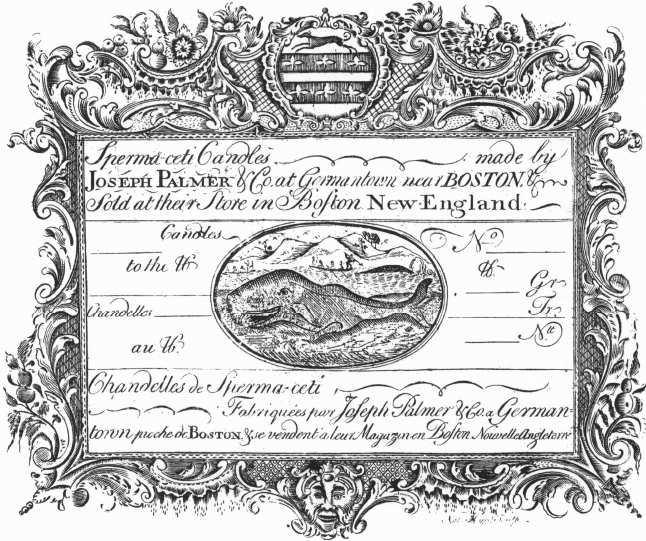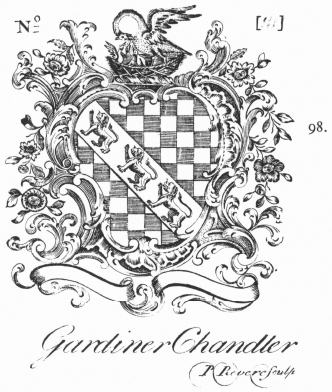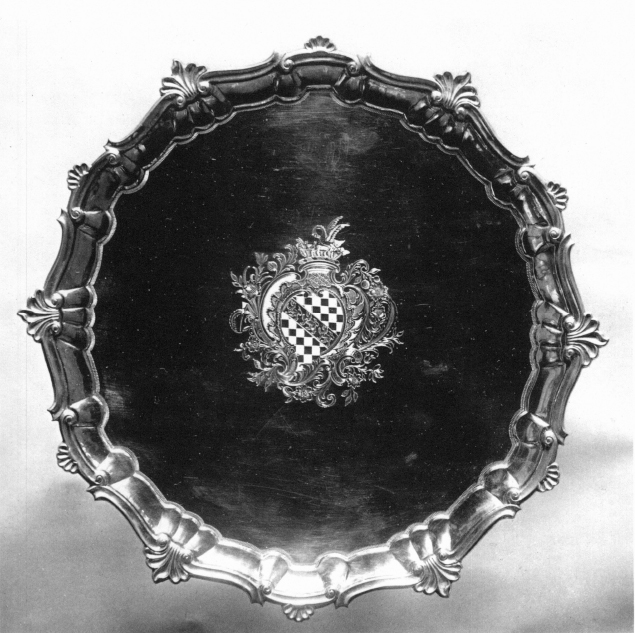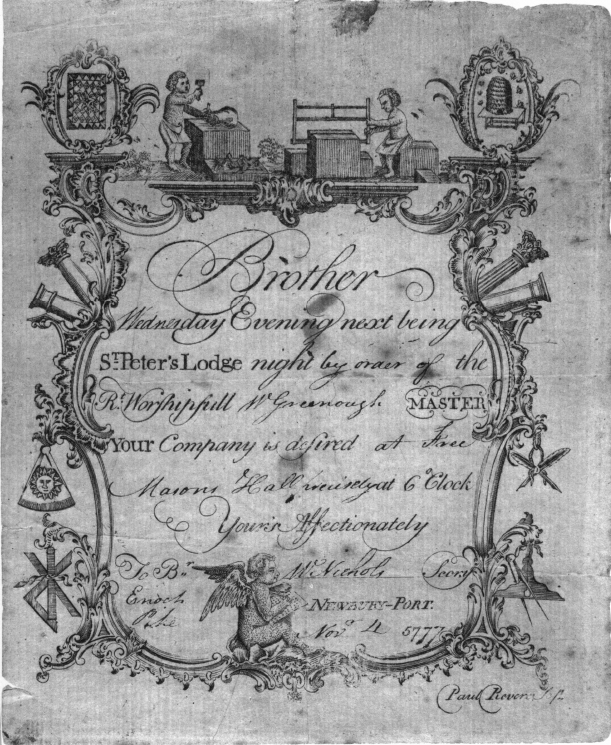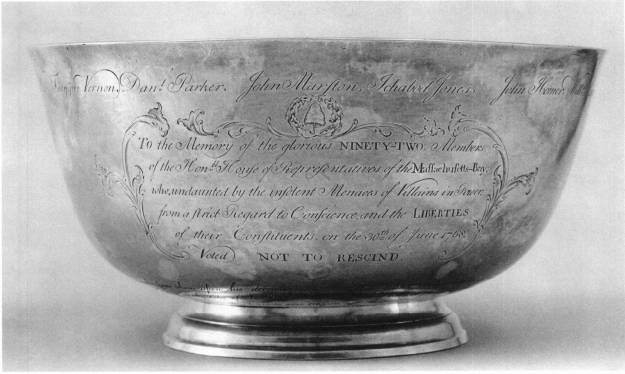Heraldic and Emblematic Engravers of Colonial Boston
IT is appropriate that the subject of heraldic and emblematic engraving should be included for discussion at a conference on Colonial American Prints and Printmakers. While not as important in some ways as the better-known areas of printmaking such as portraits, maps, and views, the cutting of emblems and arms constituted the bulk of the engraver’s work and for every view or portrait he might make, he did dozens of small jobs such as seal cutting and engraving of arms on various metals.
From the beginning, the colonists had thought in terms of emblems or symbols for their government, their institutions, their businesses, and for themselves. For the most part their needs along these lines were provided by the silversmith who was also an engraver. When the colony of Massachusetts Bay set up the first mint in 1652, it was the silversmith John Hull who was named mintmaster and who with his partner Robert Sanderson was responsible for cutting the dies for the famous New England, pine tree, oak, and willow shillings and pence, minting them from 1652 to about 1683.1 The history of these coins has been thoroughly discussed by Sidney P. Noe in three monographs published by the American Numismatic Society. Even though there is still some uncertainty as to exactly when each of the coins began to be minted, the dates can be assigned within a year or two, and it is not the purpose of this brief paper to belabor the information given in such detail by Mr. Noe, nor to retrace the information on the most famous silversmith-engraver given at length by Clarence Brigham in his definitive book on Paul Revere’s Engravings.
My purpose is to summarize the efforts of the emblematic and heraldic engravers of colonial Boston and to point out the areas most needing our further research. In the past, scholars have directed most of their attention to the earliest engravings in each category or to the most famous engravers, or to the engravings of our Revolutionary War years. Where I have been able to provide any new information, and where research is most needed, is in the intervening period, primarily in the second quarter of the eighteenth century, and with little-known engravers.
As in the case of the first coins, the earliest currency was engraved by a silversmith. Documentation is lacking but it can safely be assumed that John Coney, who was paid £30 on March 12, 1702/3 for “engraving 3 plates” for the Province of Massachusetts for the paper money issued in that year, also was responsible for the first paper money of the colony issued in 1690, due to the similarity of engraving on both issues.2 A twenty-shilling note of the 1690 issue is preserved at the Massachusetts Historical Society and displays in an oval in the lower left corner the Indian with bow and arrow between two small pine trees and the banner “Come over and help us.”
Coney’s contemporary Jeremiah Dummer of Boston in 1709 engraved the plates for the colony of Connecticut when they issued their paper money in that year. The journals of the Council record their transactions with Dummer in 1710 and on February 5, 1711/12, the Council voted payment of £144/1/2 to him “for the whole Charge of Printing 6550 Sheets of bills of Credit to the value often thousand pounds.”3 In variously shaped enclosures Dummer engraved the three staffs with grape vines symbolic of Connecticut in the lower left corner of these bills.
Whether Coney engraved the plates for all the currency issued by Massachusetts during his lifetime is not known. One of the difficulties here is that while volumes have been written on the legal history of the currency issued, less has been done on the engravers of it, and even less done in putting the specific examples of currency with the name of the engraver. At any rate, Massachusetts issued currency in 1690–91, 1702, 1708–11, 1713–14, and 1722, the year of Coney’s death. These constitute the old tenor bills.
The next issue or the issue of new tenor bills was not until the 1730’s. Nathaniel Mors was paid in 1735 for engraving and printing the plate for Massachusetts currency.4 Not much is known of Mors’s work. He engraved the portrait of Matthew Henry published in Communicant’s Companion in Boston in 1731. His son Obadiah had his ears cropped for counterfeiting. A relatively small number of examples of silver made by Nathaniel Mors survive, including a pair of octagonal candlesticks at Winterthur on which he engraved the Faneuil crest. Nevertheless, though more of his silver survives than different examples of his engraving, Nathaniel Mors was described at the time of his death in 1748 as “an ingenious engraver.” It remains to be determined how many of the plates he was responsible for in the issues of currency made by Massachusetts in 1733, 1736–37, 1740–41, and 1744. The Massachusetts Historical Society has a good collection of provincial currency, the examples of the 1740’s being decorated with both the Indian seal of the province and the royal arms.
The next engraver of currency for the colony of whom we have record was Nathaniel Hurd who engraved bills of exchange and loan certificates in addition to an emblematic table of coins and weights. At the American Antiquarian Society is an example of the treasurer’s notes issued by the Provincial General Court to pay the troops for service at Nova Scotia and Crown Point in 1761 (Fig. 84). The bill rendered by Nathaniel Hurd for engraving the plates for these notes survives in the Massachusetts Archives and Hurd signed the plate with his name and the date 1762 in the bead-and-reel border of the heavily decorated left-hand side of the note. A circular enclosure at the left of the title was left unembellished to receive a rose, crown, and thistle embossed seal.
84. Massachusetts Treasurer’s note, by Hurd, 1762
New Hampshire had issued private notes to pay for the Crown Point expedition as a notice explained in the Boston Gazette on April 28, 1755:
The Government of Piscataqua having made an act for the Emission of One Hundred and twenty Thousand Pounds, old tenor, for carrying on the Present Expedition to C—-n P—-t, And last week the Honourable Joseph Newmarch, and Clement March, Esqrs., two of their Committee, came to Town, and have agreed with an Engraver to strike off that Sum.
Modern strikes from the plates for the New Hampshire Crown Point notes are at the American Antiquarian Society (Fig. 85) and the New Hampshire Historical Society. The design for these notes is distinctive, each note being surrounded by a rococo scroll-and-shell border and having a cartouche in the lower left corner within which is shown a fort at the left, troops at the right, and in the center the trunk of a large tree bearing the inscription “PRO ARIS & FOCIS.” Various birds and animals are engraved in the lower right corner to denote different denominations, such as a squirrel for the sixpence note, a cock for three shillings, and a hare for one shilling. The larger denominations of ten shillings, fifteen shillings, thirty shillings, and three pounds have only the tree trunk with Latin inscription in the cartouche at the lower left and in an enclosure at center top are different animals and birds.
It is entirely possible that Nathaniel Hurd was the Boston engraver of these notes as they bear a favorable comparison with his other work at this same period. It is likely too that earlier New Hampshire currency well could have been engraved by Boston men. The New Hampshire notes issued in 1714, 1717, 1722, and 1724–27, engraved with the royal arms and a hedgehog on one side and the cypher of Queen Anne and a tree on the reverse, are strikingly similar in the design of the arms, cypher, and upper scroll border to the Massachusetts issues of 1711.5 The New Hampshire notes of 1737 (the original copper plate for which is at the New Hampshire Historical Society) and 1742 likewise are similar to Massachusetts notes of the same period.
While much remains to be done in sorting out and proving the engravers of provincial currency, even more promising returns await the researcher in the realm of private issues or so-called manufactory notes. At the Bostonian Society is an anonymous but handsome ten-pound note (Fig. 86) issued on August 1, 1740, in the name of Isaac Winslow. The Massachusetts Historical Society has other examples of different denominations in this issue as well as examples of manufactory notes issued in 1733 for Richard Clarke and in 1740 for Joseph Marion.
Both the Essex Institute and the Massachusetts Historical Society preserve two-shilling manufactory notes issued in the name of James Eveleth and dated May 1, 1741, which can be attributed to Thomas Johnston on the basis of the following notice which appeared in the Boston Gazette on May 18/25, 1741: “Mr. Thomas Johnson has just finish’d two of the Plates containing eight Bills, or manufactory Notes, to be forthwith emitted, by a number of Gentlemen in the County of Essex.” The Gazette goes on to quote in full a copy of the bill and its motto. The two-shilling note (Fig. 87) has a nicely engraved border, and in the lower left-hand corner in a complex frame is a wharf scene. The one-shilling note is similar but instead of the wharf there is a ship under sail with a second ship in the lower part of the enclosure.
The same men who engraved the plates for currency also provided Massachusetts with its seals on occasion. Much work remains to be done on the many seals used in the colony. As early as 1629 the silver seal of the Massachusetts Bay Colony was sent from the company in England to this country in the hands of Samuel Sharpe, a passenger in the George. The design was an Indian with bow and arrow and a leafy skirt, with the same two small pine trees noted earlier in the first paper currency, and the motto “Come over and help us.” It is quite possible that mintmaster John Hull later engraved one or more versions of this same seal due to the various impressions of it known on documents.
86. Ten-pound manufactory note, 1740
87. Manufactory notes, 1741
After 1684, there was substituted a seal with the royal arms on one side, and on the other two men on bended knees before the king, James II, one with a petition and the other offering a gift. The royal arms then continued as the provincial seal of Massachusetts Bay until June 29, 1773.
Several cuts of the Indian seal were made for use in printing. The first of these was used from 1672 on at the Cambridge press. The second cut was probably made by John Foster of Boston in 1675.6 Another cut was made about 1686 by Richard Pierce of Boston who was the official printer at that time. In 1696 what may be the first wood engraving of the royal arms made in New England was used in the form of William III’s arms accompanying “An Act for Preventing Frauds . . .” reprinted by Bartholomew Green and John Allen in Boston.7
Several other seals of an official nature are of interest which were cut by Boston engravers. In 1753 Thomas Johns(t)on cut a seal for the Proprietee of the territory in Maine, with the design of a codfish superimposed on an anchor and the motto “NEC FRUSTRA DEDIT REX.” This seal is now at the Massachusetts Historical Society.8
Also at the Massachusetts Historical Society is a receipted bill from Nathaniel Hurd to Thomas Hancock dated September 1763 for “Engraving one large Seal for Governor Wilmott, with his Coat-of-Arms.” Wilmott was governor of Nova Scotia. George Francis Dow believed that Hurd had also provided the stamps for embossing legal documents required by the act passed by the General Court of Massachusetts in 1755. These had designs of a schooner, a pine tree, a codfish, and a bird for the different denominations.9
James Turner was called upon by Benjamin Franklin to cut a seal for James Read of Philadelphia. Since Read was clerk of the Crown and prothonotary of the Supreme Court of Pennsylvania and because of Turner’s description, this was undoubtedly an official seal rather than a personal one. Turner wrote from Boston to Franklin on July 6, 1747:
Herewith I send the Seal which you so long ago Spoke to me for, for Mr. Read. The Occasion of my sending it to you and not directly to him was because that the Seal being very heavy might cause him a great Charge which I thought he might be eased of by my sending it to you as you are Postmaster. . . . I have sent with the Seal 2 Impressions from it one on wax taken off by hand the other on a Wafer taken off in Colonel B Pollards Press. [Pollard was sheriff of Suffolk Co., Mass.] The Letters show best on the latter because of its being such a large body of Metal that it chils the Wax before it can enter the Letters, but I think that either of ’em are legible enough.
Turner explained that he should have charged £15 instead of his quoted price of £12, but trusts to the gentleman’s generosity. He said, “it was but a guess as I had never done one of this Size and but one great or Small in Steel before,” and concludes by saying, “if you or any Other Gentlemen wants any graveing work done of any Sort I should be glad of an Oppertunity.”10
On October 23, 1751, the Pennsylvania Hospital Minutes (1, 16) record, “B. Franklin undertook to write to Boston tomorrow to get a seal for the Corporation engraved.” Twelve days later on November 4, 1751, John Franklin wrote from Boston to his brother, “I have spoke with Turner about your seal. He thinks he cant git the Designe Compleated before the post going but will have it Ready against the next.”11 By 1753 the hospital had received the silver seal with its device of the good Samaritan taking the sick man and delivering him to the innkeeper, with the words “Take care of him, and I will repay thee” (Fig. 5).
A number of institutional seals as well as official seals were cut by Boston silversmiths for local organizations but not as many survive from the colonial period as one might hope. The design for Harvard’s seal was first recorded in 1643, but the seal for which John Coney was paid £2/2/6 in 1693 and which was used at least until 1795 has been lost.12 The seal of Dartmouth College (Fig. 89) has been more fortunate and can be attributed to Nathaniel Hurd. Chase’s History of Dartmouth College records that at a meeting of the board on August 25, 1773, the seal of the college was adopted “agreeably to its impression upon a steel die, engraved by Mr. Nathaniel Hurd, of Boston.”13 The seal appears to have been reworked at some later date since Chase describes the design as having a label over the roof of the central building with the words “Vox clamantis in deserto” and this banner now runs diagonally from the upper right corner to the side of the building in the center. Indentations can also be seen above the roof of the building where the former banner was removed.
88. Seal of the Pennsylvania Hospital, c. 1753
Nathaniel Hurd also cut the seal for Brown University which was procured by the Reverend Samuel Stillman in 1765. The bill from Hurd to Stillman is preserved in the John Carter Brown Library but the seal survives only in the form of impressions taken from it. Hurd had also cut a seal for Moses Brown of Providence who mentioned it in a letter to Benjamin Burt of Boston on September 2, 1763.14 The Boston Marine Society’s seal with its design of a ship nearing a lighthouse after a storm was specified in a report of the society dated February 26, 1754, with the information that the seal was cut by Nathaniel Hurd. This survives in the society’s collections today although it is no longer in use. It was not until 1772 that the Salem Marine Society acquired its seal and it was cut, not by a Boston engraver, but by Mr. Hiller, probably Joseph Hiller, a Salem jeweler and watchmaker. Apparently Nathaniel Hurd also engraved the Masonic seal since some years ago John Marshall Phillips was shown a paper inscribed “Seal by Nathaniel Hurd 1752” at the Grand Lodge of Masons, but this could not be located when Hollis French prepared his book on Jacob Hurd and His Sons.
89. Seal of Dartmouth College, c. 1773
A large part of the seal cutting done by Boston engravers was done for individuals. Unfortunately, in this area even less is known. Although the designs of the seals remain on documents, and some of the seals themselves survive, there is no knowledge of precisely who cut most of them. Occasionally there are documents which show who the Boston engraver was but rarely can the document be put with the actual seal. The seal of Moses Mather cut in steel by Nathaniel Hurd is a rare exception.15 From the accounts of Paul Revere at the Massachusetts Historical Society we know that he engraved a silver seal in 1765 with the arms of Joseph Webb, and in 1772 he cut a silver seal for Simon Greenleaf, but neither of these seals appears to have survived.
Many more examples of heraldic engraving by Boston artisans exist in the form of armorial bearings engraved on silver or for bookplates. As early as 1716, Francis Dewing, who had just arrived from London, was noted as an engraver of “Coats of Arms and cyphers on Silver Plate.”16 One of the earliest coats of arms engraved on a piece of American silver is that on a covered caudle cup (Fig. 90) made by John Coney for Isaac Addington about 1680. With its square shield and widely scrolling cartouche, it represents the first style in American armorial design. At the end of the seventeenth century a plumed cartouche was also in vogue as an enclosure for a square shield. During the first two decades of the eighteenth century, the enclosure for the arms was rounded, somewhat circular or as a fat oval, with a scrolled cartouche often draped with tight chains of bell flowers as Coney used on the teapot bearing the arms of Jean Paul Mascarène (Fig. 91).
90. Addington arms and crest on covered cup made by Coney, c. 1680
91. Mascarène arms on teapot made by Coney, c. 1710
In the subsequent generation of silversmiths, Jacob Hurd continued the high quality of engraving on silver begun by Coney and his contemporaries. It was Jacob Hurd who made the Admiralty Oar about 1740, engraved with the royal arms on one side and an anchor on the other. A proportionately high part of Hurd’s silver, especially teapots, coffeepots, and trays, was engraved with arms such as those on the Lowell-Leversedge teakettle-on-stand at the Museum of Fine Arts and the Colman-Bulfinch arms on the tray in the Heritage Foundation at Deerfield (Fig. 92). For the most part the engraving was characterized by a cartouche comprised of scrolls and leafage with shells. In the 1740’s an outer strapwork border enclosed a shaped shield, and diapering or imbrication filled the area between the shield and the cartouche.
92. Detail of Colman-Bulfinch arms on tray made by Jacob Hurd, c. 1740
One of the earliest engravers of armorial bookplates in Boston was Thomas Johnston.17 When Charles Dexter Allen wrote his book on American Bookplates in 1894, there was some confusion as to how many examples of Johnston’s work there actually were, due to the fact that two bookplates were signed “Johnston” and one was signed “Johnson.” There seems no doubt now that these were all the work of the same man and that they constitute the first signed examples of the bookplate art in Boston in the late 1730’s or early 40’s.
Stylistically earliest is the handsome Jacobean plate which he engraved for William P. Smith with a strong and balanced cartouche. A bookplate engraved for Joseph Tyler and a more hastily delineated rococo example for Samuel Willis complete the published signed examples by Johnston. At his death in 1767, however, there was listed in his inventory a “Book of Heraldry” valued at forty-eight shillings.18 In addition Johnston engraved a coat of arms in the middle of the lower section of his fanciful prospect of Yale College, 1749, in dedicating the print to Jonathan Law, governor of Connecticut.
Such heraldic work was closely related to the engraving of trade cards for shop owners in Boston. Johnston’s earliest work of this sort was probably the unsigned but dated plate he did for Thomas Hancock, bookseller, in 1727 when he was just coming of age. (His birthdate is generally given as about 1708.) The print, now at the Massachusetts Historical Society, took the form of Hancock’s shop sign, a wooden frame suspended and swinging between two iron rods, featuring the emblem of his shop, the Bible and Three Crowns. Below the sign, the various types of books and writing equipment available at his shop were listed. With the cupid’s heads at the base of the frame and the owner’s initials and the date displayed in cartouches in the crest at the top, Hancock’s card is quite similar to the trade card Thomas Johnston engraved for his own use as a Japanner at the sign of the Golden Lyon in Anne Street. Similar to both these trade cards is one, also attributed to Johnston, dated 1736 and used by Samuel Grant whose emblematic sign was the Crown and Cushion, in which the date occupies both of the cartouches in the crest, and a shell has been substituted for the cherub’s head in the base of the frame. The latest trade card and the only one signed by Thomas Johnston was done about 1765 for John Gould, Jr., a merchant of English goods at the sign of the Crown and Sceptre. This card at the Worcester Art Museum, in addition to its suspended, Chippendale-style shop sign, has an elaborately engraved rococo border surrounding the entire plate.19
In 1748, James Turner signed his only known trade card at the base of the post supporting the shop sign of Joseph and Daniel Waldo, which is suspended from an elaborate and lovely wrought iron bracket. As merchants of a very long list of goods imported from London, the Waldos used a heavily laden elephant as their shop sign. Closely competing with Johnston as an engraver in Boston, James Turner decorated his “Chart of the Coasts of Nova-Scotia” with the arms of Governor Edward Cornwallis in 1750. Turner’s earliest surviving bookplate is that of John Franklin (Fig. 93) and it is one of the finest early American bookplates known, not only because of the complexity of its design but because of the skill in its execution. In fact it justifies the opinion of Isaiah Thomas in his history of printing in America that Turner “was the best engraver which appeared in the colonies before the revolution.”20
93. Bookplate of John Franklin, by Turner, c. 1745
More examples of Turner’s bookplates are known from his Philadelphia period (c. 1752–53 to 1759). At least it must be assumed the bookplates he signed for Isaac Norris and Sir John St. Clair and the attributed plate for James Hall, all residents of Philadelphia, were done while Turner was living there since there is no evidence of their being ordered from Boston and the style of the plates is compatible with his Philadelphia years. It is altogether likely, however, that it was the bookplate and other work that Turner did for John Franklin that procured him the patronage of Benjamin Franklin to whom Turner wrote on July 6, 1747, “. . .it has been my Ill fortune ever Since I have been for my Self to be Involved in a great deal of large Unprofitable Silver Smiths work which was particularly my Case when your Brother Mr. J Franklyn procured me a large Job of Engraveing.”21
One of the “large Unprofitable” objects Mr. Turner referred to was the tankard which he made for Richard Derby which is currently on loan to the Essex Institute (Fig. 94). It is probably the same tankard named in a bill in the Essex Institute Library as being bought from Turner by Captain Richard Derby on October 22, 1746, along with a pair of cans. The bill specifies the charges for making and engraving the tankard at fifteen pounds, in addition to the cost of the silver. On the front of the tankard is a noteworthy coat of arms in a balanced baroque cartouche with bold strapwork borders. In addition to the outline for the escutcheon, attention should be drawn to the certainty of the scrolls, the tightly tied swags which are attached to several of the furls along the base of the cartouche, and the distinctive and intricate diapering of the space between the coat of arms and the foliated cartouche.
These particular features, in addition to overall similarities, make it possible to suggest here that it probably was James Turner who also engraved the large covered cup which was made by William Swan and presented in 1749 to Benjamin Pickman for his contributions at the Battle of Louisburg (Fig. 95). It has long seemed unlikely that Swan did the engraving himself since there is not a consistent recurrence of such decoration on other examples of his work. In the First Church of Marblehead there are two flagons, one engraved with the Barnard arms and the other with the Hooper arms, which were made in 1748–49 by Samuel Burt of Boston, and these too appear to have been engraved by James Turner who was originally from Marblehead.22
94. Tankard with Derby arms by Turner, c. 1746
95. Covered cup by William Swan, 1749, with engraving probably by Turner
It was not uncommon for silversmiths to pay someone else to do engraving for them. Revere’s account books show that he did engraving for such silversmiths as John Coburn and Samuel Minott. By the same token it is evident from the Revere account books that Nathaniel Hurd bought unengraved silver, notably salvers, from Revere and it is logical to assume that he may then have engraved them for one of his own customers. Nathaniel Hurd made and marked his own silver as well. Furthermore he owned his own copy of Guillim’s Display of Heraldry and was shown in Copley’s portrait with the 1724 edition of it beside him. With this volume Hurd could readily provide his customers with a coat of arms—whether or not they were entitled to bear them according to the regulations of the College of Heralds in England. In actuality there are a few proven instances in which, if the American silversmith could not find arms listed for his customer, he would look in the index of Guillim for the nearest name approximating his customer’s and cheerfully appropriate them for his unarmed patron.
The use of Guillim by Hurd can be seen in the case of a teapot in the Hollis French Collection at the Cleveland Museum of Art which bears on its side the Gibbs arms (Fig. 96a). The design of these arms can be found in Guillim in unembellished form with a verbal description (Fig. 96b). It is interesting to see that Hurd changed the straight plain handles of the hatchets to the prettier mid-eighteenth-century style of turned handle and neatly elaborated the cartouche into a florid and ruffled asymmetrical enclosure for the arms.
The same translation was made by Hurd for a teapot at Winterthur emblazoned with the Howard arms which Hurd presumptuously usurped through the help of Guillim from the arms which Henry VIII gave to his fourth wife Lady Katherine Howard. For the arms included beneath Hurd’s portrait of the Reverend Joseph Sewall, family tradition may have been the source rather than Guillim. However, Guillim was the basis for at least twenty-eight of the fifty-five different arms which Nathaniel Hurd engraved as bookplates. The bookplates of Jonathan French, Benjamin Greene, and Wentworth are only a few examples.
96(a). Teapot by Nathaniel Hurd, engraved with the Gibbs arms, c. 1765
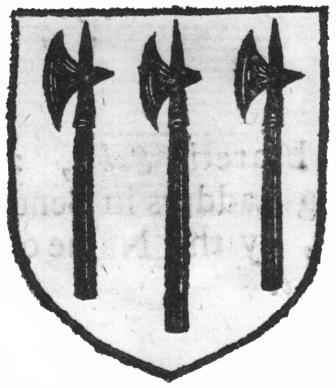
96(b). Gibbs arms from 1724 edition of Guillim’s Display of Heraldry
97. Sperma-ceti Candles, advertisement engraved by Hurd, before 1754
Hurd’s first dated bookplate was done in 1749, two years approximately before he came of age. That the engraving of bookplates was one of his most important commissions as an engraver can be seen from the fact that Hollis French was able to attribute to Nathaniel Hurd 110 different varieties and states of armorial bookplates, an amazingly large number of which—forty of them—were signed by Hurd.
In preparing a trade card for chandler Joseph Palmer sometime before 1754 Hurd added a coat of arms in the upper central section of an ornate rococo frame. For its design he combined two different descriptions by Guillim of Palmer arms. Using the basic design of the arms shown for William Palmer, Esquire, of Warwickshire, with a greyhound above two bars, he added twice as many trefoils slipped in the bars, as Guillim showed for an earl, Roger Palmer. Of special interest in this trade card is the emblematic central scene advertising Palmer’s spermaceti candles, showing a whaling scene. This and the plate which Hurd did about the same time or a few years earlier for George Rome of Newport, also a seller of spermaceti candles, may well be the first American representations of whaling scenes. George Rome’s advertisement shows a vignette above, as well as the pursuit depicted in a very inventive manner in the scrolled border at the bottom of the card. Along the sides of the frame can be seen the instruments emblematic of the whaler’s occupation.
By the second half of the eighteenth century, objects representing the stock of a merchant were frequently shown on trade cards in addition to or instead of the shop sign. An example combining the two was engraved about 1755 by Hurd for Ziphion Thayer at the Golden Lion in Cornhill. A mahogany and gilt looking glass and a very stylish side chair were selected for illustration from the goods imported from London by Thayer.
Paul Revere engraved a billhead for Joshua Brackett for his tavern at Cromwell’s Head in School Street. Cromwell is depicted in a grape-draped cartouche at the top, and the charges for Wine, Punch, and Liquor could be itemized below along with Board, Lodging, Horsekeeping, and Oats. Brackett’s trade card is not listed in Revere’s surviving account books but those which he did for William Breck and Joseph Webb are noted.
Webb’s advertisements were bought from Revere on September 28, 1765, when he paid three pounds for the engraving of a copper plate and seven shillings for the printing of 150 of them. The design is a perfect delight with all the pots and kettles, irons, fire backs, spiders, and teapots hanging from the branches of the rococo frame, and flags decorating the upper section. For the antiquarian, William Breck’s advertisement is much less interesting, although it is more sophisticated in its florid frame. Breck was charged by Revere for 300 prints in 1772. The dominant emblem above the list of imported goods which Breck had for sale is the Golden Key, the sign of his shop.
98. Bookplate of Gardiner Chandler by Revere, c. 1765
Revere’s accounts show that he engraved a number of hat advertisements as well as bookplates. On September 27, 1764, he charged Epes Sargent twelve shillings for “Engraving your arms on a Copper Plate” and six shillings for printing 150 copies of it. The arms of Sargant (sic) of Staffordshire were described in Edmundson’s Heraldry as a chevron between three dolphins embowed. The design of the frame, with its scrolls and leaves and flowers is almost identical to the bookplates Revere engraved for Gardiner Chandler (Fig. 98) and John Gardiner, as well as for Andrew Oliver, Isaiah Thomas, and for his own use.
99. Silver salver by Revere, engraved with the Chandler arms, c. 1761
The same arms and crest in a different frame were engraved by Revere on the Chandler silver salver, now at the Museum of Fine Arts in Boston, made about 1761 for Lucretia Chandler (Fig. 99). For every coat of arms Revere engraved on a copper plate for bookplates, he must have engraved at least ten coats of arms on pieces of silver, if we can trust the percentage of surviving examples.
This is true of other silversmiths and engravers less well known and less well studied than Revere, and much more attention should be paid to the engraving on silver made by Revere’s contemporaries such as the Burts and the Edwards. For instance, Joseph Edwards, Jr., charged Joshua Green £0/18/8 in 1765 for engraving a pair of cans with the Green arms according to the design given in Guillim. Such a billing does not prove decisively that Joseph Edwards, Jr., himself engraved the arms, because he still could have paid someone else in his own shop or elsewhere to do it for him. Nor can we be certain without further study that Thomas Dane himself did the verbose engraving of the tankard presented in 1757 to Joseph Frye featuring the arms which Guillim said “pertain’d to Robert Frye of the City of Exeter, Gent.”
Another fertile field for the emblematic engraver was in the engraving of membership certificates and notifications. Frequently he had already cut the organization’s seal or in the case of a Masonic lodge may have made the silver and gold jewels or emblems of its officers and members. Although there are no colonial marine certificates known, a number of other membership certificates survive. In fact, the engraving of the view of the North Battery done by Revere about 1762 and so important as a view of Boston was in reality a type of membership certificate showing that the bearer was an enlisted montross in his majesty’s service.
Revere’s accounts indicate that he was one of the favored engravers of Masonic certificates and notifications, as well as of their jewels. The large general certificate, which he engraved about 1773, was also signed by him as master of the lodge, and includes many of the emblems of the fraternity of Masons, as does the St. Peter’s Lodge notification and that of St. Andrew’s (Fig. 100). He engraved notifications for other Massachusetts lodges as well as the Masonic lodge in Surinam. In addition in 1771 he made 400 prints for notices of the Fire Club in Boston for Dr. Philip G. Kast.
100. St. Peter’s Lodge meeting notice, by Revere, 1772
Nathaniel Hurd, who had cut the seal for the Masonic lodge, also engraved a summons for them about 1764 which includes at the base the coat of arms of the Provincial Grand Lodge of Masons. His brother Benjamin Hurd engraved Masonic certificates which he signed as a Mason “Brother B. Hurd del.”
An invitation of a different sort was engraved by Nathaniel Hurd for Mr. Bernard and Mr. Oxnard when they held a dance at the Town House after the Harvard Commencement in 1767. This plate is known today only from later restrikes, the example at the American Antiquarian Society being labeled on the back “Impression from the Copper Plate used at the time of the graduation of my Grandfather Oxnard, Harvard 1767.”
There was throughout the eighteenth century a growing demand for the engraver to provide the colony with emblems, whether for official imprints or for the mastheads of newspapers as they sprang up. For the most part, the makers of the woodcuts used still remain unidentified. In addition to the sailing ship, the pine tree, and the Indian seen earlier as emblems of the colony of Massachusetts, newspaper illustrations became increasingly emblematic of the desire for liberty from the 1750’s on. The segmented snake, each section labeled to represent the various colonies, with the motto “Join or Die,” generally regarded as the first American political cartoon, appeared on May 9, 1754, in Franklin’s Pennsylvania Gazette and in the Boston Gazette twelve days later on May 21, 1754, with the additional words “Unite and Conquer.” While James Turner, who by then had moved to Philadelphia and who is known to have cut the Penn arms for the masthead of the Pennsylvania Gazette, may well have done the Philadelphia version of the rattlesnake, the Boston version remains anonymous. It is not beyond the realm of possibility that Turner could also have cut the design used in the Boston paper and sent it by post so that it could appear within two weeks in both cities. In 1774 Revere cut for The Massachusetts Spy a banner with a more elongated serpent with the sections symbolically closer together. In the next two years a totally unified snake forming a circle, in a classic form representing unity and eternity with its tail in its mouth, appeared in both Pennsylvania and Massachusetts.23
101. Liberty bowl by Revere, 1768
Other popular emblems of liberty such as the apprentice’s freedom cap and the Magna Carta, both of which appeared on Revere’s famous Liberty Bowl (Fig. 101) in 1768, were used in mastheads of the Boston Gazette and The Massachusetts Spy, both cut by Revere. In 1775 when he engraved the notes for the Colony of Massachusetts Bay, Revere put the Liberty Cap pole in the hand of an Indian. In a cartouche above he put the symbol of the codfish which, like the pine tree, had been a peacetime symbol of Massachusetts. The same year he cut the first seal of the State of Massachusetts which was an English American holding a sword and the Magna Carta with the motto “By the sword we seek peace, and peace only under liberty” in Latin.24
This hasty sketch of the heraldic and emblematic engravings of colonial Boston I hope has conveyed some idea of the magnitude of this area of American engraving. It was the silversmith-engraver who, in a way, gave the colonists a sense of identity, whether by providing him with a coat of arms or by supplying him with the symbols of his authority or of his liberty.

